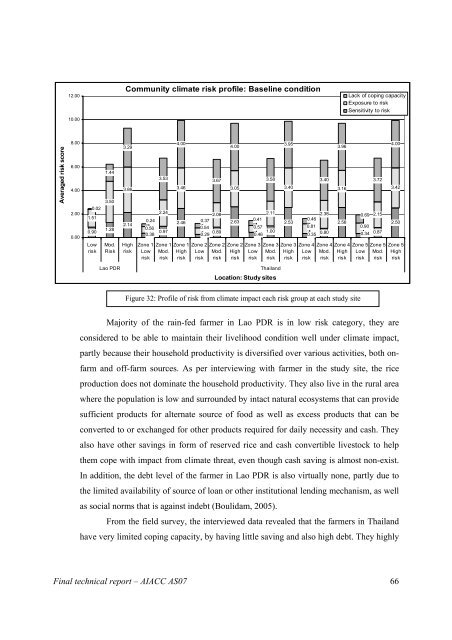Final Technical Report - weADAPT
Final Technical Report - weADAPT
Final Technical Report - weADAPT
- No tags were found...
You also want an ePaper? Increase the reach of your titles
YUMPU automatically turns print PDFs into web optimized ePapers that Google loves.
12.00<br />
10.00<br />
Community climate risk profile: Baseline condition<br />
Lack of coping capacity<br />
Exposure to risk<br />
Sensitivity to risk<br />
Averaged risk score<br />
8.00<br />
6.00<br />
4.00<br />
2.00<br />
0.00<br />
0.02<br />
1.51<br />
0.90<br />
Low<br />
risk<br />
1.44<br />
3.50<br />
1.28<br />
Mod.<br />
Risk<br />
3.29<br />
3.86<br />
2.14<br />
High<br />
risk<br />
3.53<br />
4.00<br />
3.46<br />
3.67<br />
4.00<br />
3.05<br />
2.24<br />
2.08<br />
2.11<br />
2.38<br />
0.69 2.15<br />
0.24<br />
2.46<br />
0.37<br />
0.41 0.46<br />
2.63<br />
2.53<br />
2.56<br />
0.56 0.54 0.57 0.81 0.90<br />
0.97<br />
0.89<br />
1.00<br />
0.80<br />
0.87<br />
0.38 0.29 0.46 0.35 0.34<br />
Zone 1<br />
Low<br />
risk<br />
Zone 1<br />
Mod.<br />
risk<br />
Zone 1<br />
High<br />
risk<br />
Zone 2<br />
Low<br />
risk<br />
Zone 2<br />
Mod.<br />
risk<br />
Zone 2<br />
High<br />
risk<br />
Zone 3<br />
Low<br />
risk<br />
3.58<br />
Zone 3<br />
Mod.<br />
risk<br />
3.95<br />
3.40<br />
Zone 3<br />
High<br />
risk<br />
Zone 4<br />
Low<br />
risk<br />
3.40<br />
Zone 4<br />
Mod.<br />
risk<br />
3.96<br />
3.16<br />
Zone 4<br />
High<br />
risk<br />
Zone 5<br />
Low<br />
risk<br />
3.72<br />
Zone 5<br />
Mod.<br />
risk<br />
4.00<br />
3.42<br />
2.50<br />
Zone 5<br />
High<br />
risk<br />
Lao PDR<br />
Thailand<br />
Location: Study sites<br />
Figure 32: Profile of risk from climate impact each risk group at each study site<br />
Majority of the rain-fed farmer in Lao PDR is in low risk category, they are<br />
considered to be able to maintain their livelihood condition well under climate impact,<br />
partly because their household productivity is diversified over various activities, both onfarm<br />
and off-farm sources. As per interviewing with farmer in the study site, the rice<br />
production does not dominate the household productivity. They also live in the rural area<br />
where the population is low and surrounded by intact natural ecosystems that can provide<br />
sufficient products for alternate source of food as well as excess products that can be<br />
converted to or exchanged for other products required for daily necessity and cash. They<br />
also have other savings in form of reserved rice and cash convertible livestock to help<br />
them cope with impact from climate threat, even though cash saving is almost non-exist.<br />
In addition, the debt level of the farmer in Lao PDR is also virtually none, partly due to<br />
the limited availability of source of loan or other institutional lending mechanism, as well<br />
as social norms that is against indebt (Boulidam, 2005).<br />
From the field survey, the interviewed data revealed that the farmers in Thailand<br />
have very limited coping capacity, by having little saving and also high debt. They highly<br />
<strong>Final</strong> technical report – AIACC AS07 66
















